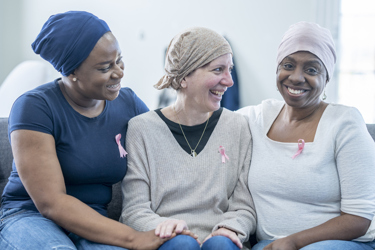How Clinical Research Can Be A Path To Clinical Care For Minority Health
By Courtney Shihabuddin, DNP, APRN-CNP, AGPCNP-BC, chief quality officer, BJEConsultants, The Ohio State University College of Nursing

The journey from clinical research to clinical care is a critical pathway that holds immense potential, particularly for minority populations who have historically been underrepresented in medical studies. More inclusive clinical research can and will improve health outcomes for women, especially those from minority backgrounds who are disproportionately affected by breast cancer.
Understanding The Disparities
Breast cancer is a leading cause of cancer-related deaths among women globally. However, the impact is not uniform across different populations. Minority women, particularly African American and Hispanic women, experience higher incidence rates and poorer outcomes compared to their white counterparts. These disparities are multifaceted, involving genetic differences, socioeconomic factors, access to healthcare, and, notably, underrepresentation in clinical trials.
Clinical trials are the cornerstone of medical advancements, yet minority participation remains alarmingly low. According to the FDA, while minorities make up nearly 40% of the U.S. population, they represent less than 20% of clinical trial participants. This underrepresentation limits the generalizability of clinical findings and perpetuates health disparities.
Root Causes Of Disparities
The root causes of these disparities are complex and interwoven. Socioeconomic factors such as income, education, and access to healthcare play a significant role. Minority women often face barriers to accessing high-quality healthcare, including lack of insurance, transportation issues, and cultural barriers. Additionally, historical mistrust of the medical system due to past unethical research practices contributes to lower participation in clinical trials. Genetic and biological differences may also influence cancer incidence and treatment outcomes.
A study published in the Journal of Clinical Oncology found that African American women have a 42% higher mortality rate from breast cancer compared to white women, even when adjusting for socioeconomic factors. This stark statistic underscores the urgent need for more inclusive research.
The lack of minority participation in clinical trials can lead to slower improvements in health outcomes for these groups. For example, survival rates for breast cancer have improved over the past decades, but the rate of improvement has been slower for African American women compared to white women, partly due to disparities in access to new treatments and clinical trials.1
The Role Of Clinical Research
Clinical research serves as a bridge between scientific discovery and clinical application. It is through rigorous trials that new treatments, drugs, and interventions are tested for safety and efficacy. For minority women with breast cancer, participation in clinical research can provide access to cutting-edge therapies.
Minority participation in clinical research is not just a matter of equity but also scientific necessity. Diverse populations in clinical trials ensure that the findings apply to a broader demographic, leading to better, more personalized care for all patients. Moreover, it helps identify specific genetic, biological, and environmental factors that might influence treatment responses among different groups.
Clinical trials also can serve as a treatment option for patients, offering access to potentially life-saving therapies that are not yet widely available. This aspect is particularly crucial for minority women who might not have other means of accessing these advanced treatments.
5 Strategies To Enhance Minority Participation
- Community Engagement and Trust Building: Building trust within minority communities is crucial. Historical abuses in medical research have left a legacy of distrust. Organizations must engage with community leaders and stakeholders to foster relationships based on transparency and mutual respect.
Tactical approaches include:
- Partner with local community organizations to host informational sessions about clinical trials.
- Establish community advisory boards to guide research efforts and address community concerns.
- Conduct outreach through culturally relevant media channels.
- Partner with Federally Qualified Health Centers (FQHC) as a conduit for education and referrals for clinical trial participants
- Culturally Competent Communication: Effective communication is key to encouraging participation. Materials and information about clinical trials should be available in multiple languages and tailored to cultural contexts. This ensures that potential participants fully understand the purpose, procedures, and benefits of the study. Cultural humility has a profound impact on patient recruitment and team dynamics within clinical research. Providing a basic understanding of cultural humility allows one to recognize and address power dynamics in patient-provider interactions, engage in active listening and validate patients’ cultural perspectives, and provide cultural competence training for research staff.
- Reducing Barriers to Participation: Budget for diversity-related costs as a discrete line item. Practical barriers such as transportation, childcare, and time off work often deter minority women from participating in clinical trials. Providing logistical support and financial compensation can alleviate these obstacles. Flexible study designs that consider the participants' needs and circumstances are also essential. Researchers should conduct preliminary surveys or focus groups to understand specific barriers faced by minority communities. They also can collaborate with community organizations to gather insights and co-develop solutions.
- Diverse Research Teams: Having a diverse team of researchers and healthcare providers can enhance trust and communication. Patients are more likely to participate in studies when they see themselves represented among the professionals conducting the research.2
- Regulatory and Policy Support: Policymakers and regulatory bodies must prioritize diversity in clinical research. Implementing guidelines and incentives for the inclusion of minority populations in trials can drive systemic change. To make significant improvements, there is a need for policies that mandate reporting of demographic data in clinical studies. To support these efforts, we need to advocate for policies that mandate demographic reporting in clinical trials and support legislation that provides funding and resources for diversity initiatives in research.
The Impact on Clinical Care
The ultimate goal of clinical research is to translate findings into clinical practice that improve patient outcomes. For minority women with breast cancer, this means more effective and tailored treatments. Research that includes diverse populations can lead to the development of therapies that address specific genetic markers prevalent in these groups. It also can inform guidelines for screening, prevention, and management tailored to the unique needs of minority women.
My experience as a breast cancer survivor illustrates the profound impact of research on patient care. Due to my family history of breast cancer, I had been observed in a high-risk screening program since the age of 24, when I found my first lump and had my first biopsy. After my scans had suspicious findings, I was approached to participate in a clinical study where any tissue collected received genetic screening for specific markers to help advance cancer care. I consented. However, not all patients may. Genetics research can be extremely complicated, and with the previous history of researchers using tissue samples illegally, such as the case of Henrietta Lacks, others may be hesitant to consent to this type of participation.3 Advances in breast cancer treatment have significantly improved survival rates and quality of life for many women. According to the National Cancer Institute, the five-year relative survival rate for breast cancer increased from 75% in the 1970s to 90% in recent years, thanks to advances in research and treatment.4
However, there must be inclusive representation. Ensuring that clinical research includes and addresses the needs of minority populations is a step toward this goal. Studies have shown that minority groups have seen less improvement in outcomes due to underrepresentation in clinical research. For example, the American Cancer Society reports that while breast cancer death rates have dropped by 40% overall since 1989, the decline has been less pronounced among African American women, highlighting the need for more inclusive research.4
Clinical research is a powerful tool in the fight against breast cancer, with the potential to significantly improve outcomes for minority women. By addressing the barriers to participation and ensuring that studies are inclusive, we can develop more effective treatments that benefit everyone. This includes making a commitment to quality and equity in clinical trials and advocating for a future where every woman, regardless of her background, has access to the best possible care. This pathway from research to clinical care is not just a scientific endeavor but an obligation to ensure health equity.
References:
- African American Women and Breast Cancer. Breast Cancer Prevention Partners (BCPP). Accessed June 12, 2024. https://www.bcpp.org/resource/african-american-women-and-breast-cancer/
- To Increase Diversity in Clinical Trials, First Increase Staff Diversity | Tufts University School of Medicine. Accessed July 5, 2024. https://medicine.tufts.edu/news-events/news/increase-diversity-clinical-trials-first-increase-staff-diversity
- Beskow LM. Lessons from HeLa Cells: The Ethics and Policy of Biospecimens. Annu Rev Genomics Hum Genet. 2016;17:395-417. doi:10.1146/annurev-genom-083115-022536
- Breast Cancer Facts & Figures. Accessed June 12, 2024. https://www.cancer.org/research/cancer-facts-statistics/breast-cancer-facts-figures.html
About The Author:
 Courtney Shihabuddin was diagnosed with breast cancer at the age of 35 and has worked tirelessly since her diagnosis to advocate for young women with breast cancer. She currently serves as the chief quality officer at BJE Consultants, where her expertise in enhancing patient experience, collaborating with patient advocacy groups, and implementing evidence-based practices plays a pivotal role in elevating healthcare quality. With a deep-seated passion for patient-centered care, Courtney has distinguished herself as a leader dedicated to the intersection of quality improvement and patient advocacy.
Courtney Shihabuddin was diagnosed with breast cancer at the age of 35 and has worked tirelessly since her diagnosis to advocate for young women with breast cancer. She currently serves as the chief quality officer at BJE Consultants, where her expertise in enhancing patient experience, collaborating with patient advocacy groups, and implementing evidence-based practices plays a pivotal role in elevating healthcare quality. With a deep-seated passion for patient-centered care, Courtney has distinguished herself as a leader dedicated to the intersection of quality improvement and patient advocacy.
In her role, Courtney orchestrates initiatives that not only meet but exceed standards in patient care, ensuring that every strategy is grounded in robust evidence and best practices. Her approach integrates comprehensive patient feedback, fostering an environment where patient voices are central to shaping care processes and outcomes.
